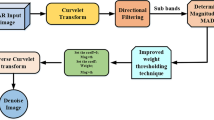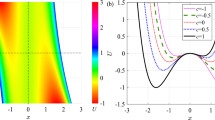Abstract
In this paper, we investigate the problem of analysis of low probability of interception (LPI) radar signals with intra-pulse frequency modulation (FM) under low signal-to-noise ratio conditions from the perspective of an airborne electronic warfare (EW) digital receiver. EW receivers are designed to intercept and analyse threat radar signals of different classes, received over large dynamic range and operating independently over large geographical spread to advice host aircraft to undertake specified actions. For an EW receiver, primary challenges in interception and analysis of LPI radar signals are low received power, intra-pulse modulations, multi-octave frequency range, wide signal bandwidth, long pulse width, vast and multi-parametric search space, etc. In the present work, a method based on match filterbank localization and Taylor’s series approximation for analysing the entire family of intra-pulse FM radar signals is proposed. The method involves progressive, joint time–frequency (TF) localization of the signal of interest (SOI), under piecewise linearity and continuity assumptions on instantaneous frequency, to effectively capture local TF signatures. Detection is by information-theoretic criterion based hypotheses testing, while estimation and classification are based on polynomial approximation. Fine signal analysis is followed by synthetic reconstruction of the received signal slope. Detection, estimation and classification performances for the prominent FM radar signal classes are quantified based on simulation study statistics. Stagewise implementation of analysis and FM slope reconstruction, in realistic radar threat scenarios, is demonstrated for the potential SOIs. Subject discussion is organized from the perspective of practical EW system design and presented within the realm of signal processing architecture of concurrent EW digital receivers.







Similar content being viewed by others
References
Tsui J B 2004 Digital techniques for wideband receivers, 2nd edn. Scitech, North Carolina, USA
Cohen L 1995 Time–frequency analysis. Prentice Hall, New Jersey, USA
M/s Thales Group 2012 Product Datasheet VIGILE advanced naval R-ESM/ELINT systems. www.thalesgroup.com
M/s Selex ES 2014 Product Datasheet SAGE advanced digital ESM.www.selex-es.com
M/s Saabgroup 2015 Product Datasheet SIRIUS airborne SigInt system. www.saabgroup.com
M/s Rockwell Collins 2009 Product Datasheet CS3045 airborne ELINT/ESM subsystem. www.rockwellcollins.com/ewsigint
Pace P E 2004 Detecting and classifying low probability of intercept radar. Artech House Inc, Massachusetts, USA
Taboada F L 2002 Detection and classification of LPI radar signals using parallel filter arrays and higher order statistics. MS Project Thesis. USA: Naval Post Graduate School, US Navy
Raju V V S R N, Pavan Kumar R, Singh A K and Subba Rao K 2012 LPI radar signal detection, identification and classification using digital receiver, Second international Conference on Electronic Warfare, EWCI-2012, Bangalore, India, pp. 522–528
Lunden J and Koivunen V 2007 Automatic radar waveform recognition. IEEE J. Sel. Top. Signal Process. 1(1): 124–136
Lunden J, Terho L and Koivunen V 2005 Classifying pulse compression radar waveforms using time frequency distributions. In: Proceedings of the Conference on Info Sciences and Systems, The Johns Hopkins University, March 2005
Cornu C, Ioana C, and Quinquis A 2004 Characterization of LPI waveforms using polynomial phase signal modelling. In: proceeding of the International Conference on Radar Systems, Toulouse, France. [Online]. Available: https://hal.archives-ouvertes.fr/hal-00518788
Geroleo F G and Brandt-Pearce M 2012 Detection and estimation of LFMCW radar signals. IEEE Trans. Aerosp. Electron. Syst. 48(1): 405–418
Stoica P and Moses R 2005 Spectral analysis of signals. Prentice-Hall, New Jersey, USA
Stoica P and Selen Y 2004 Model-order selection. IEEE Signal Process. Mag. 1053-5888/04:36–47
Hamschin B, Clancy J, Grabbe M, Fortier M and Novak J 2014 In: Proceedings of the Passive detection, characterization, and localization of multiple LFMCW LPI signals. IEEE Radar Conference, pp. 537–543
Oh D and Lee J H 2015 Low-complexity range-azimuth FMCW radar sensor using joint angle and delay estimation without SVD and EVD. IEEE Sens. J. 5(9): 4799–4811
Zhou Y, Wang X, Tian Y and Zhou D 2015 A novel time–frequency atomic dictionary for radar intra-pulse modulation signal sparse representation. In: Proceedings of IEEE Microwave Conference (APMC), Asia Pacific, vol. 1, pp. 1–3
Guner K K, Erkmen B, Gulum T O, Yasin Erdogan A, Yildirim T and Ata L D 2016 Implementation aspects of Wigner–Hough Transform based detectors for LFMCW signals. In: Proceeding of the \(39^{th}\) IEEE International Conference on Telecommunications and Signal Processing, pp. 441–444
Rossouw van der Merwe J, du Plessis W P, Maasdorp F D V and Cilliers J E 2016 Introduction to low probability of recognition to radar system classification. In: Proceedings of the IEEE Radar Conference, pp. 1–5
Neves S R, de Oliveira A, Serra R, Segadilha L E, Monteiro F and Lopez J M 2016 Using wavelet packets to analyze FM LPI radar signals. In: Proceeding of the IEEE Sensor Array and Multichannel Signal Processing Workshop (SAM), pp. 1–4
Lopez-Risueno G and Grajal J 2006 Multiple signal detection and estimation using atomic decomposition and EM. IEEE Trans. Aerosp. Electron. Syst. 42(1): 84–102
Lopez-Risueno G, Grajal J, Omar A, Ojeda Y, Sanz-Osorio A and Moreno J A 2003 Two digital receivers based on time-frequency analysis for signal interception. In: Proceedings of the conference IEEE Radar
Lopez-Risueno G, Grajal J and Ojeda Y 2003 Atomic decomposition based radar complex signal interception. IEEE Proc. Radar Sonar Navig. 150(4): 323–331
Skolnik M L 2001 Introduction to radar systems, 3rd edn. Tata Mcgraw-Hill, Delhi, India
Sayed A H 2008 Adaptive filters. Wiley-IEEE Press, New Jersey, USA
Edwin K P Chong and Stanislaw H Zk 2001 An introduction to optimization, 2nd edn. Wiley, New York, USA
Acknowledgements
Authors are thankful to The Director, Indian Institute of Science, Bangalore, The Director, Naval Physical and Oceanographic Laboratory, Kochi, and The Director, Defence Avionics Research Establishment, Bangalore, for the academic and organizational support. The present work is based on the academic project undertaken by A R Sachin as a part of his Master of Engineering (Telecommunications) Degree program, under the guidance of Prof K V S Hari, in association with Dr Sooraj K Ambat, during 2011–2013, in Statistical Signal Processing Lab, Department of Electrical Communication Engineering, Indian Institute of Science, Bangalore.
Author information
Authors and Affiliations
Corresponding author
Rights and permissions
About this article
Cite this article
SACHIN, A.R., AMBAT, S.K. & HARI, K.V.S. Analysis of intra-pulse frequency-modulated, low probability of interception, radar signals. Sādhanā 42, 1037–1050 (2017). https://doi.org/10.1007/s12046-017-0672-2
Received:
Revised:
Accepted:
Published:
Issue Date:
DOI: https://doi.org/10.1007/s12046-017-0672-2




